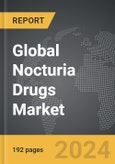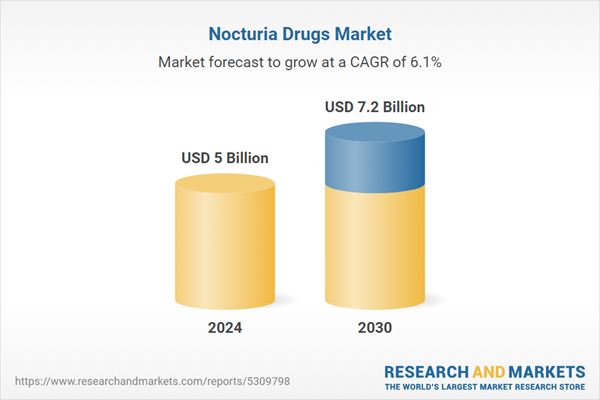Global Nocturia Drugs Market - Key Trends & Drivers Summarized
What Are Nocturia Drugs and Why Are They Essential for Managing the Condition?
Nocturia is a medical condition characterized by excessive urination during the night, which can disrupt sleep and lead to daytime fatigue, reduced quality of life, and other health complications. Nocturia drugs are pharmaceutical treatments designed to manage the symptoms of this condition by reducing urine production, relaxing bladder muscles, or treating underlying causes such as overactive bladder, benign prostatic hyperplasia (BPH), or diabetes. These drugs include desmopressin, anticholinergics, alpha-blockers, and diuretics, which help patients manage frequent nighttime urination and improve their sleep patterns.Nocturia drugs are important because they address a common yet often underdiagnosed condition that affects millions of people, particularly the elderly. Chronic nocturia can lead to sleep deprivation, which is associated with increased risks of cardiovascular disease, cognitive decline, and falls, especially in older adults. Effective treatment with nocturia drugs can significantly improve patients' sleep quality, overall health, and well-being, making them an essential component of healthcare for individuals dealing with this condition.
How Is the Nocturia Drugs Market Evolving?
The nocturia drugs market is evolving with the increasing awareness of nocturia as a medical condition and the growing demand for effective treatments. One of the key trends is the rising adoption of desmopressin-based drugs, which are highly effective in reducing nighttime urine production. These drugs mimic the natural hormone vasopressin, helping the kidneys absorb more water and reducing the frequency of urination during the night. As healthcare providers recognize the impact of nocturia on quality of life, desmopressin therapies are becoming more widely prescribed, particularly for elderly patients.Another important trend is the development of combination therapies that target both bladder muscle relaxation and urine production. These therapies are designed to treat patients with complex conditions, such as those with overactive bladder or benign prostatic hyperplasia (BPH), who experience nocturia as a secondary symptom. Additionally, the market is seeing growth in patient-centered approaches, including personalized treatments based on individual symptoms, underlying conditions, and response to medication, which is enhancing the effectiveness of nocturia management.
Which Patient Groups Are Driving the Demand for Nocturia Drugs?
The demand for nocturia drugs is primarily driven by the aging population, as nocturia is more common among older adults. Elderly individuals often experience nocturia due to conditions such as overactive bladder, benign prostatic hyperplasia (BPH), or cardiovascular diseases that increase nighttime urine production. As life expectancy rises globally, the prevalence of nocturia is also increasing, driving demand for effective treatments to manage this condition.Additionally, patients with underlying health conditions, such as diabetes or heart disease, are significant users of nocturia drugs. These conditions often lead to increased urine production, requiring targeted treatments to address nocturnal symptoms. Women experiencing postmenopausal changes and hormonal imbalances are another key demographic, as they are at higher risk of developing nocturia. Healthcare providers are increasingly recognizing nocturia as a condition that affects a wide range of patients, prompting a greater focus on comprehensive treatment strategies.
What Are the Key Growth Drivers in the Nocturia Drugs Market?
The growth in the nocturia drugs market is driven by several factors, starting with the increasing prevalence of nocturia among aging populations. As more elderly individuals experience this condition, the demand for medications that improve sleep and quality of life is rising. Healthcare providers are increasingly diagnosing and treating the condition, which is leading to a greater adoption of nocturia drugs, particularly desmopressin-based therapies.Advances in drug development, including combination therapies and more targeted treatments, are also contributing to market growth. These innovations are improving the effectiveness of nocturia treatments, leading to better outcomes for patients with complex or severe symptoms. Additionally, the rising prevalence of chronic diseases, such as diabetes and cardiovascular conditions, is boosting demand for nocturia medications, as these conditions often contribute to nighttime urination. The growing focus on improving the quality of life for elderly patients is further driving the expansion of the nocturia drugs market.
Report Scope
The report analyzes the Nocturia Drugs market, presented in terms of market value (USD). The analysis covers the key segments and geographic regions outlined below.- Segments: Indication (Low Nocturnal Bladder Capacity, Mixed Nocturia, Global Polyuria, Nocturnal Polyuria); Drug Type (Desmopressin, Anticholinergic Drugs, Antispasmodic, Antibiotics, Other Drug Types).
- Geographic Regions/Countries: World; United States; Canada; Japan; China; Europe (France; Germany; Italy; United Kingdom; and Rest of Europe); Asia-Pacific; Rest of World.
Key Insights:
- Market Growth: Understand the significant growth trajectory of the Low Nocturnal Bladder Capacity Indication segment, which is expected to reach US$3 Billion by 2030 with a CAGR of 6.3%. The Mixed Nocturia Indication segment is also set to grow at 6% CAGR over the analysis period.
- Regional Analysis: Gain insights into the U.S. market, valued at $1.4 Billion in 2024, and China, forecasted to grow at an impressive 5.6% CAGR to reach $1.1 Billion by 2030. Discover growth trends in other key regions, including Japan, Canada, Germany, and the Asia-Pacific.
Why You Should Buy This Report:
- Detailed Market Analysis: Access a thorough analysis of the Global Nocturia Drugs Market, covering all major geographic regions and market segments.
- Competitive Insights: Get an overview of the competitive landscape, including the market presence of major players across different geographies.
- Future Trends and Drivers: Understand the key trends and drivers shaping the future of the Global Nocturia Drugs Market.
- Actionable Insights: Benefit from actionable insights that can help you identify new revenue opportunities and make strategic business decisions.
Key Questions Answered:
- How is the Global Nocturia Drugs Market expected to evolve by 2030?
- What are the main drivers and restraints affecting the market?
- Which market segments will grow the most over the forecast period?
- How will market shares for different regions and segments change by 2030?
- Who are the leading players in the market, and what are their prospects?
Report Features:
- Comprehensive Market Data: Independent analysis of annual sales and market forecasts in US$ Million from 2024 to 2030.
- In-Depth Regional Analysis: Detailed insights into key markets, including the U.S., China, Japan, Canada, Europe, Asia-Pacific, Latin America, Middle East, and Africa.
- Company Profiles: Coverage of players such as AA Pharma Inc., Allergan PLC, Avadel Pharmaceuticals PLC, Ferring Pharmaceuticals, Glenmark Pharmaceuticals Ltd. and more.
- Complimentary Updates: Receive free report updates for one year to keep you informed of the latest market developments.
Some of the 38 companies featured in this Nocturia Drugs market report include:
- AA Pharma Inc.
- Allergan PLC
- Avadel Pharmaceuticals PLC
- Ferring Pharmaceuticals
- Glenmark Pharmaceuticals Ltd.
- Teva Pharmaceutical Industries Ltd.
- Urigen Pharmaceuticals, Inc.
This edition integrates the latest global trade and economic shifts into comprehensive market analysis. Key updates include:
- Tariff and Trade Impact: Insights into global tariff negotiations across 180+ countries, with analysis of supply chain turbulence, sourcing disruptions, and geographic realignment. Special focus on 2025 as a pivotal year for trade tensions, including updated perspectives on the Trump-era tariffs.
- Adjusted Forecasts and Analytics: Revised global and regional market forecasts through 2030, incorporating tariff effects, economic uncertainty, and structural changes in globalization. Includes historical analysis from 2015 to 2023.
- Strategic Market Dynamics: Evaluation of revised market prospects, regional outlooks, and key economic indicators such as population and urbanization trends.
- Innovation & Technology Trends: Latest developments in product and process innovation, emerging technologies, and key industry drivers shaping the competitive landscape.
- Competitive Intelligence: Updated global market share estimates for 2025, competitive positioning of major players (Strong/Active/Niche/Trivial), and refined focus on leading global brands and core players.
- Expert Insight & Commentary: Strategic analysis from economists, trade experts, and domain specialists to contextualize market shifts and identify emerging opportunities.
Table of Contents
Companies Mentioned (Partial List)
A selection of companies mentioned in this report includes, but is not limited to:
- AA Pharma Inc.
- Allergan PLC
- Avadel Pharmaceuticals PLC
- Ferring Pharmaceuticals
- Glenmark Pharmaceuticals Ltd.
- Teva Pharmaceutical Industries Ltd.
- Urigen Pharmaceuticals, Inc.
Table Information
| Report Attribute | Details |
|---|---|
| No. of Pages | 192 |
| Published | December 2025 |
| Forecast Period | 2024 - 2030 |
| Estimated Market Value ( USD | $ 5 Billion |
| Forecasted Market Value ( USD | $ 7.2 Billion |
| Compound Annual Growth Rate | 6.1% |
| Regions Covered | Global |









